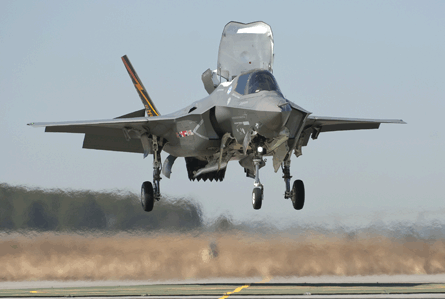Questions raised over 2004 weight-saving decision to switch key F-35 structures from titanium to new aluminium alloy
Lockheed Martin has discovered fatigue cracks on an aluminium bulkhead inside a ground test aircraft for the short take-off and landing F-35B variant after 1,500h of durability testing.
The cracks have had no immediate impact on the pace of the flight-test programme. While the engineers are performing a root cause analysis on the BH-1 durability test aircraft, Lockheed has inspected and cleared the flight test fleet and the ground test aircraft for the conventional take-off and landing F-35A variant.
 |
|---|
© Lockheed Martin |
Meanwhile, Alcoa, which supplies the 6 x 2m (19.7 x 6.5ft) aft bulkhead, has told Flight International that the discovery of the fatigue cracks is not expected to "have any impact on the current [F-35] production schedule". Alcoa has a team of engineers working with Lockheed on the root-cause analysis.
Among the possible causes is a test malfunction, a manufacturing error or a design flaw, Lockheed says. As the durability test airframe, BH-1 was being subjected to forces simulating aerodynamic loads the airframe would experience over two lifetimes, or 16,000h. The fatigue cracks were revealed by a special inspection within the first one-tenth period of the testing cycle.
Until now, Lockheed's ground tests to verify the strength and safety of the F-35 structure had progressed smoothly. In June, for example, the CTOL AG-1 airframe completed static testing that proved the airframe can survive 13.5g loads, or 150% higher than Lockheed's required limit of 9g.
As recently as last year, US government officials repeatedly cited the results of static and durability testing as a sign of confidence that Lockheed's analytical predictions were accurate.
The public view of the F-35 programme is largely shaped by the struggles and achievements of the nearly four-year-old flight-test programme and the manufacturing system. With few exceptions Lockheed's ground tests have been conducted behind the scenes.
Lockheed has performed arduous series of structural tests and analyses on all three F-35 variants over the past seven years.
Following the F-35's building block test approach, the company has analysed the durability and damage tolerance of the structures, starting with coupons, then components and, finally, full-scale aircraft such as BH-1.
As the investigation continues, questions will be raised about a key decision in the 2004 redesign. As part of a broader strategy to reduce airframe weight, Lockheed decided to switch from titanium to a new Alcoa alloy - 7085 - for the load-bearing bulkheads.
For Alcoa, Lockheed's decision was an industrial coup. Designed for a wing spar in the Airbus A380, the 7085 alloy had received its first military customer. Three years later, in May 2007, an Alcoa executive touted this success in a briefing to financial analysts.
"The aircraft [F-35] was overweight. They needed significant weight reductions," Alcoa Power and Propulsion president Ray Mitchell said. "They were trying to do it with a two-piece solution. We were able to, with our proprietary alloys, offer them a single piece solution that would be lighter weight and greater strength. So they redesigned this entire part of the airplane and didn't lose time."
Single-piece structures
Alcoa delivers each of the bulkheads in single-piece structures forged by the company's 50,000t press in Cleveland, Ohio.
Lockheed has not commented on the basis of the decision to switch from titanium to aluminium alloy bulkheads. The durability tests were conducted "early in the development of a new programme to avoid costly sustainment issues later".
The F-35 development programme was launched nine years ago, but it is early in the production programme. As a cost-saving strategy, the programme launched low-rate initial production in 2007, nearly a decade before the flight-test programme ends.
The Government Accountability Office has expressed concerns that buying so many F-35s during the development phase increases the risk of major cost overruns, as design changes discovered during ground and flight tests must be retrofitted on to delivered aircraft.
Meanwhile, the Defense Acquisition Board is meeting on 22 November to consider major changes to the F-35 programme, which reportedly include the elimination of the STOVL variant. Leaked results of a technical baseline review conducted by the programme office show the F-35 faces new delays and up to $5 billion in cost overruns.
Source: Flight International























